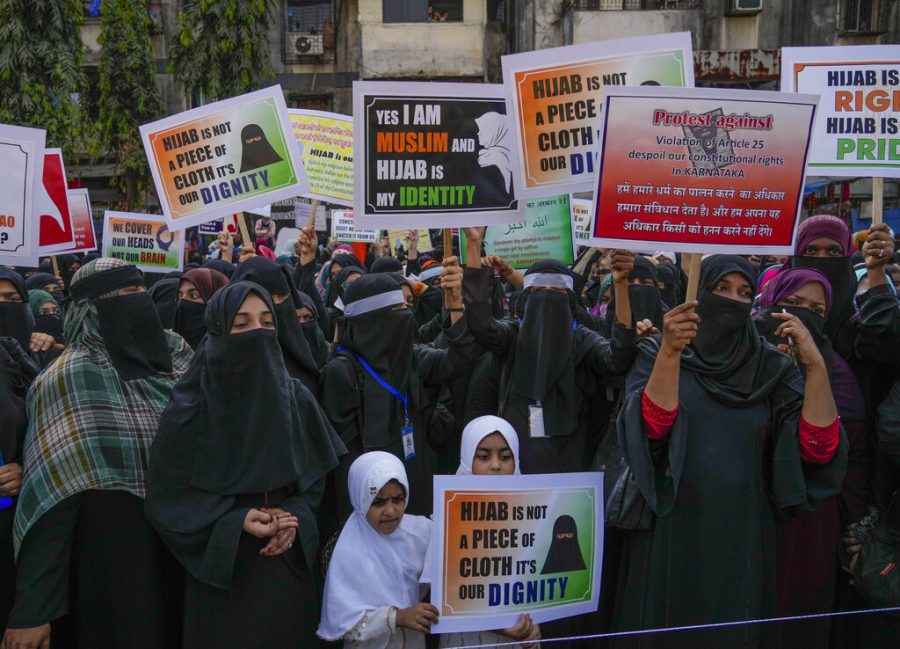The feminist hypocrisy on villainizing hijab for ‘freedom’
Struggles of women wearing hijabs are ignored and forgotten
A few months ago, after the death of 22 year old Iranian Mahsa Amini—who was killed under the custody of the Iranian morality police due to not wearing the traditional Islamic headscarf worn by Muslim women—a global movement was born.
Around the world and especially in Iran, people stood in solidarity against forced hijab. People cut their hair, protested on the street, and fought back against Iranian authorities, rallying under the slogan “zan, zendegi, azadi,” or “women, life, freedom.”
Yet, at the same time, Muslim hijabis in France have struggled since 2004 to attend school due to a governmental ban on the headscarf. The same story exists in India, where Muslim women are denied education due to their religious attire. This struggle for existence can be found around the world for Muslim women, who have started their own protest movements like #HandsOffMyHijab and confronted opposition like in the viral video of Muskan Khan, who was trying to go to school in Karnataka, India while standing off against anti-hijab protestors.
Hypocritically, the mainstream media and the same voices that speak out against the violence that can be found in Iran, which run generally on the tenets of western liberal feminism, fail to rally behind this struggle. Feminism, as a movement, has long been associated with the fight for gender equality and the empowerment of women. However, there seems to be a glaring contradiction when it comes to the issue of hijab.
One of the most prominent examples of this hypocrisy can be seen in the case of France, where hijabi women face discrimination in schools, public beaches, sports competitions, and political campaigns.
Muslim women are forced out of schools because of their religious dress, are discriminated against, and are told that they are being trapped by their hijab. In fact, much of the France—-41.6% in the latest election—would go so far as to support far-right politicians like Marine Le Pen who suggested a nationwide hijab ban in all public places.
The hypocrisy is shameless and brazen; France, who for hundreds of years have been fueled by ideals of liberty, forces Muslim women to systematically and nonconsensually undress themselves and violate their freedom of choice.
The issue begins with the image of the hijab and how it is perceived in the rest of the world. For outsiders, the sight of a hijab perpetuates a message of oppression and subjugation. When people see hijab, they associate it with government authorities like Iran.
Yet, this couldn’t be further from the truth. Iran isn’t Islam, and according to the Quran 2:256, there is “no compulsion in religion, for the truth stands out clearly from falsehood.”
In fact, for hundreds of millions of Muslim women, the hijab is a liberation from the bonds of sexualization and objectification put onto them by western society.
Look at the stories of Muslim women like Olympic fencer and author Ibtihaj Muhammad, who broke barriers as a hijabi woman.
Her children’s book, “The Proudest Blue,” talks about her experience of wearing hijab to school for the first time and how “hijab was a part of me.” Her story of competing in the Olympics as a hijabi woman, which was discussed in a book talk for staff and students on Jan. 30 during lunch periods at the Winnetka campus library, shows how she broke barriers and became a role model for young Muslim American women struggling to wear hijab.
In fact, listening to the experiences of hijabi women, the hijab serves as an alternative to how women are treated in the western world. People assume hijab is oppressive because a religious doctrine asks women to cover up, while the Western notion of feminism seems to encourage women to take off their clothes to feel more empowered.
Hijab is an expression of modesty which applies to both men and women, giving them control over their own bodies. It emphasizes character and intellect over appearance.
You can see it in the reactions against the hijab in France; people have been programmed to expect women to dress a certain way and when they see something that challenges that view, they fight against it.
For many Muslim women, Islam and the hijab is an escape from living in that reality; instead, they live in a way in which they retain control over their bodies.
As a Muslim man, I will never relate to the struggles of a Muslim woman. I will never be as identifiable as a hijabi like my own mother in public, the very image which conjures immediate assumptions in the eyes of many.
And as a result, I will never be as brave. This is why it’s important to have discussions like this; hijabi women are the beacon of light of Islam, and if we are true to our word, we can rally to safeguard the rights for women to wear their hijab with the same slogan of “zan, zendegi, azadi”—women, life, and freedom.







































